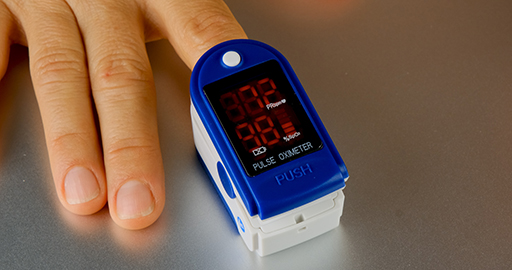1.4 Management of acute episodes of asthma in hospital
Episodes of acute asthma are differentiated as moderate, severe and life-threatening. British National Formulary (2019) differentiates between these acute episodes in Table 2 below. SpO2 measures the amount of oxygen in the blood using a pulse oximeter; in an acute episode normal saturation for children over 2 years of age is 94–98%. High flow oxygen therapy via a nasal cannula or tight-fitting face mask would typically be administered in these circumstances.

| Moderate | Severe | Life threatening |
|---|---|---|
|
|
Any one of the following in a child with severe asthma:
|
Activity 5 Typical treatment of acute episodes in the hospital environment
Source the following article via an internet search and respond to the points that follow. If you are a healthcare professional, you may want to complete the ‘time out’ activities in the article and use this as evidence of continuing professional development. This is not part of the course.
Article: Sheldon, G. et al. (2018) Nursing management of paediatric asthma in emergency departments. Emergency Nurse. Doi: 10.7748/en.2018.e1770
You can source this article online by entering the title into a Google search and downloading it from the source on ResearchGate.
Remember, to avoid losing your place in the course, you should search for article in a new tab or window.
- Write down the risk factors from Box 1 in the article and note down how you might prevent an exacerbation of asthma.
- What clinical signs and symptoms might be used when assessing the severity of an asthma exacerbation?
- What is included in the examination of an acute episode of asthma?
- What are the most common medications used for an acute episode of asthma?
- Write a reflective account of 300–500 words about what you have learned about asthma from this article.
- What did you learn?
- How might this knowledge help you in the future?
Discussion
Some of the risk factors include respiratory tract infections, exposure to tobacco smoke, allergies, change of seasons, age, gender, pollution.
Moderate asthma: oxygen saturations of more than 92%, peak flow more than 50% of usual or predicted, no features of severe or life-threatening asthma.
Acute severe: oxygen saturations of less than 92%, peak flow 33-50% of usual or predicted, cannot form complete sentences, increase heart rate, increased respiratory rate.
Life-threatening: oxygen saturations of less than 92%, peak flow less than 33% of usual or predicted, silent chest, pale skin, low blood pressure, confusion, exhaustion.
Examination of an acute episode of asthma includes:
- taking a history to find out about the child’s activities, treatment, management and health
- an examination that includes assessment of skin and hands, breathing patterns, peak flow, movement and symmetry of the chest, any scars indicating previous surgery, check lymph nodes in the neck, expansion of the chest wall, heartrate, percussion of the chest wall, listen to the chest for example, for wheezing.
The most common medications used for an acute episode of asthma are:
- Salbutamol
- Prednisolone
- Ipratropium bromide
- Aminophylline
- Magnesium sulphate.
Section 1 has allowed you to explore complexities of child development through a biological condition, asthma. You will now explore the experiences of having a child diagnosed with a developmental/intellectual disorder/learning disability.
